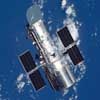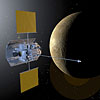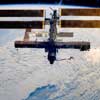|
Sunday:
March 14, 2004 | |
0332 GMT |
 |
Satellite finds something fishy about Santa Ana winds
Southern California's legendary Santa Ana winds wreak havoc every year, creating hot, dry conditions and fire hazards. Despite their often-destructive nature, a study of the "Devil Winds," conducted using data from NASA's Quick Scatterometer (Quikscat) spacecraft and its SeaWinds instrument shows the winds have some positive benefits.
 FULL STORY FULL STORY
 |  |

|
 |
Telescope on high mountain plateau in Chile studied
Cornell University and the California Institute of Technology have signed an agreement committing the two institutions to collaborate on the planning for a 25-meter infrared telescope high in the Atacama Desert of northern Chile.
 FULL STORY FULL STORY
 |  |

|
 |
Student experiments to fly aboard future NASA flights
NASA has selected students from six high schools around the country to prepare and fly their experiments on future NASA space flights. The student experiments will be flown on a NASA suborbital sounding rocket in June or on a future Space Shuttle flight, following the program's Return to Flight.
 FULL STORY FULL STORY
 |  |

|
 |
|
Saturday:
March 13, 2004 | |
2212 GMT |
 |
Mobile communications satellite launched for Asia
Lockheed Martin's Atlas 3 rocket put on a late-night sky show Saturday, ripping a fiery trail to space to deploy the Mobile Broadcasting Satellite that will transmit video, music and news to the palm of your hand.
 FULL STORY FULL STORY
 MISSION STATUS CENTER MISSION STATUS CENTER
 TIME-LAPSE PHOTO OF LAUNCH TIME-LAPSE PHOTO OF LAUNCH
 |  |

|
 |

Video coverage for subscribers only:
 VIDEO: ATLAS 3A ROCKET LIFTS OFF WITH MBSAT QT VIDEO: ATLAS 3A ROCKET LIFTS OFF WITH MBSAT QT
 VIDEO: THE LAUNCH AS SEEN THROUGH T+5 MINUTES QT VIDEO: THE LAUNCH AS SEEN THROUGH T+5 MINUTES QT
 VIDEO: NARRATED ANIMATION OF THE LAUNCH SEQUENCE QT VIDEO: NARRATED ANIMATION OF THE LAUNCH SEQUENCE QT
 VIDEO: OVERVIEW OF MBSAT SPACECRAFT AND MISSION QT VIDEO: OVERVIEW OF MBSAT SPACECRAFT AND MISSION QT
 VIDEO: POST-LAUNCH COMMENTS FROM MANAGERS QT VIDEO: POST-LAUNCH COMMENTS FROM MANAGERS QT
 ADDITIONAL VIDEO COVERAGE ADDITIONAL VIDEO COVERAGE
 SUBSCRIBE NOW SUBSCRIBE NOW

|
Clumps in Saturn's rings
Scientists have only a rough idea of the lifetime of clumps in Saturn's rings - a mystery that Cassini may help answer. The latest images taken by the Cassini-Huygens spacecraft show clumps seemingly embedded within Saturn's narrow, outermost ring.
 FULL STORY FULL STORY
 |  |

|
 |
NEWSWIRE Links to news across the internet
|
 |
Russia replaces space agency chief -- (Reuters) Russia replaced without explanation its long-serving space agency chief on Friday and appointed a top general to replace him, Russian media reported.

Neil Armstrong endorses Bush's space plan -- (AP) Former astronaut Neil Armstrong says Americans should support President Bush's plan for renewed missions to the moon and beyond.

Yellowstone could help find life on Mars -- (AP) A study of microscopic organisms that inhabit the park's hot springs may help NASA researchers in their efforts to find life on Mars.
|
 |
|
Friday:
March 12, 2004 | |
0147 GMT |
 |
MBSAT satellite cleared for Saturday morning launch
After resolving last-minute insurance issues, builder of the MBSAT mobile broadcasting satellite has affirmed plans to launch the craft in the predawn hours Saturday atop a Lockheed Martin Atlas 3A rocket.
 FULL STORY FULL STORY
 MISSION STATUS CENTER - updates MISSION STATUS CENTER - updates
 LAUNCH EVENTS TIMELINE LAUNCH EVENTS TIMELINE
 GROUND TRACK MAP GROUND TRACK MAP
 |  |

|
 |
Gehman's initial review of Hubble mission released
At Thursday's hearing of the Senate Appropriations Subcommittee that funds NASA, Administrator Sean O'Keefe was questioned about his decision to cancel the final servicing mission for the Hubble Space Telescope. Sen. Mikulski released an initial review of the safety issues related to a servicing mission prepared by Admiral Harold Gehman, chair of the Columbia Accident Investigation Board.
 FULL STORY FULL STORY
 |  |

|
 |
Spirit looks down into crater after reaching rim
NASA's Spirit has begun looking down into a crater it has been approaching for several weeks, providing a view of what's below the surrounding surface.
 FULL STORY FULL STORY
 |  |

|
 |

Video coverage for subscribers only:
 VIDEO: THURSDAY'S SCIENCE AND ROVER STATUS BRIEFING QT VIDEO: THURSDAY'S SCIENCE AND ROVER STATUS BRIEFING QT
 SUBSCRIBE NOW SUBSCRIBE NOW

|
|
Thursday:
March 11, 2004 | |
0428 GMT |
 |
Spirit heads for crater rim
The Spirit rover has nearly reached its long-sought destination -- Bonneville Crater. Meanwhile, Opportunity is passing the halfway mark of its primary mission by studying the hole it cut in the bedrock outcropping.
 MISSION STATUS CENTER MISSION STATUS CENTER
 |  |

|
 |
Atlas 3 rocket launch postponed 24 hours
Launch of the Lockheed Martin Atlas 3A rocket and MBSAT mobile communications spacecraft has been pushed back to the predawn hours of Saturday. The satellite's builder requested the 24-hour postponement.
 MISSION STATUS CENTER - updates MISSION STATUS CENTER - updates
 LAUNCH EVENTS TIMELINE LAUNCH EVENTS TIMELINE
 GROUND TRACK MAP GROUND TRACK MAP
 |  |

|
 |
Mercury orbiter undergoes final launch preps
NASA's MESSENGER spacecraft, the first Mercury orbiter, has arrived in Florida in advance of its May 11 launch a Boeing Delta 2 rocket. The "MESSENGER" name is short for MErcury Surface, Space ENvironment, GEochemistry, and Ranging.
 FULL STORY FULL STORY
 |  |

|
 |
|
Wednesday:
March 10, 2004 | |
0319 GMT |
 |
Hubble's deepest view ever unveils earliest galaxies
Astronomers on Tuesday unveiled the deepest portrait of the visible universe ever achieved by humankind. Called the Hubble Ultra Deep Field, the million-second-long exposure reveals the first galaxies to emerge from the so-called "dark ages," the time shortly after the big bang when the first stars reheated the cold, dark universe. The new image should offer new insights into what types of objects reheated the universe long ago.
 FULL STORY FULL STORY
 |  |

|
 |
NASA creates portrait of life and death in the universe
In a small galaxy lies a luminous cloud of gas and dust, called a nebula, which houses a family of newborn stars. If not for the death of a massive star millions of years ago, this stellar nursery never would have formed.
 FULL STORY FULL STORY
 |  |

|
 |
New method measures bone loss in astronauts
A team of NASA-funded researchers from University of California-San Francisco and Baylor College of Medicine has used a new method to measure and characterize bone loss caused by prolonged spaceflight.
 FULL STORY FULL STORY
 |  |

|
 |
Opportunity rover carves another hole in bedrock
After its earlier attempt stalled, Opportunity has successfully used the Rock Abrasion Tool to grind a 3.1 millimeter-deep hole in the "Mojo 2" target on "Flatrock." The cutting occurred early Tuesday -- the rover's 44th workday on Mars.
 MISSION STATUS CENTER MISSION STATUS CENTER
 |  |

|
 |
|
Tuesday:
March 9, 2004 | |
0629 GMT |
 |
Rovers watch solar eclipses by Martian moons
NASA's Mars Exploration Rovers have become eclipse watchers. Opportunity is the first space probe to see moons pass in front of the sun from the surface of another world.
 FULL STORY FULL STORY
 |  |

|
 |
Atlas to launch mobile communications satellite
Lockheed Martin's next-to-last Atlas 3 rocket is ready to launch a satellite that will broadcast video, radio and data services to portable receivers across Japan and South Korea for mobile users on the go. Liftoff from Florida is scheduled for Thursday night/Friday morning.
 MISSION STATUS CENTER MISSION STATUS CENTER
 |  |

|
 |
X-rays from Saturn pose puzzles for scientists
The first clear detection of X-rays from the giant, gaseous planet Saturn has been made with NASA's Chandra X-ray Observatory. Chandra's image shows that the X-rays are concentrated near Saturn's equator, a surprising result since Jupiter's X-ray emission is mainly concentrated near the poles. Existing theories cannot easily explain the intensity or distribution of Saturn's X-rays.
 FULL STORY FULL STORY
 |  |

|
 |
|
Monday:
March 8, 2004 | |
0425 GMT |
 |
The great 'bunny' chase at Mars rover landing site
Like a rabbit in a hat, the identity of an oddity that looks like "bunny ears" in a picture from Mars has eluded the science and engineering teams. The public, also fascinated with the mysterious object, has asked in a slew of e-mails: What is it?
 FULL STORY FULL STORY
 |  |

|
 |
NASA embarks on sweeping airborne expedition
An international team of scientists from NASA and other research institutions embarked on a three-week expedition of discovery that will take them from the lush, dense rain forests of Central America to the frigid isolation of Antarctica.
 FULL STORY FULL STORY
 |  |

|
 |

